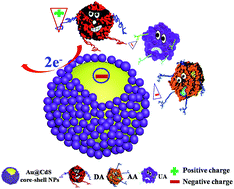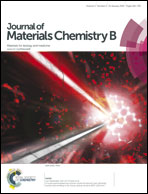Designed self-assembled hybrid Au@CdS core–shell nanoparticles with negative charge and their application as highly selective biosensors
Abstract
A novel and general strategy for the synthesis of a monodispersed Au@CdS core–shell structure with uniform morphology and size through a self-assembly process is proposed here. The obtained negatively charged Au@CdS hybrid core–shell nanoparticles (NPs) are highly selective to dopamine (DA), in the presence of oxidation of ascorbic acid (AA) and uric acid (UA), based on electrostatic interaction. The fabricated biosensor shows a wide linear range from 0.002 to 800 μmol L−1, with a lower detection limit of 0.55 nmol L−1 (n = 5, S/N = 3), revealing the high-sensitivity properties. Electrostatic charge plays an important role in the selective electrocatalytic activity of Au@CdS hybrid core–shell nanoparticles, that is the formation of an electrostatic system between the negatively charged Au@CdS hybrid core–shell NPs and the DA cation. The modified electrode is used to achieve the real-time quantitative detection of DA for biological applications, and satisfactory results are obtained. Due to the advantages of the biosensor, its selectivity, sensitivity and stability, it will have a bright future in the field of medical diagnosis.

- This article is part of the themed collection: JMC B Top Picks web collection: Seeing the unseen: Advances in bioimaging and biosensors

 Please wait while we load your content...
Please wait while we load your content...